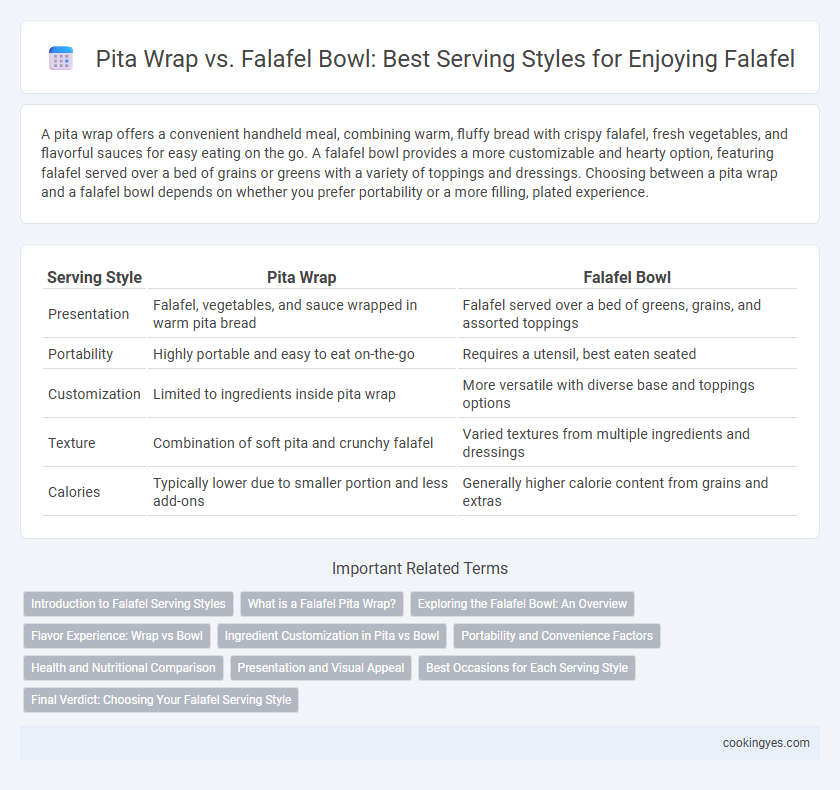A pita wrap offers a convenient handheld meal, combining warm, fluffy bread with crispy falafel, fresh vegetables, and flavorful sauces for easy eating on the go. A falafel bowl provides a more customizable and hearty option, featuring falafel served over a bed of grains or greens with a variety of toppings and dressings. Choosing between a pita wrap and a falafel bowl depends on whether you prefer portability or a more filling, plated experience.
Table of Comparison
| Serving Style | Pita Wrap | Falafel Bowl |
|---|---|---|
| Presentation | Falafel, vegetables, and sauce wrapped in warm pita bread | Falafel served over a bed of greens, grains, and assorted toppings |
| Portability | Highly portable and easy to eat on-the-go | Requires a utensil, best eaten seated |
| Customization | Limited to ingredients inside pita wrap | More versatile with diverse base and toppings options |
| Texture | Combination of soft pita and crunchy falafel | Varied textures from multiple ingredients and dressings |
| Calories | Typically lower due to smaller portion and less add-ons | Generally higher calorie content from grains and extras |
Introduction to Falafel Serving Styles
Falafel can be served in various styles, with pita wraps and falafel bowls being the most popular choices. Pita wraps offer a convenient, handheld option that combines falafel with fresh vegetables, sauces, and pickles inside warm, soft flatbread, enhancing portability and texture. Falafel bowls provide a gluten-free alternative, featuring falafel atop a bed of greens, grains, and an assortment of toppings for a customizable and nutrient-rich meal.
What is a Falafel Pita Wrap?
A Falafel Pita Wrap consists of crispy falafel balls wrapped inside soft, warm pita bread, often accompanied by fresh vegetables, tahini sauce, and pickles. This serving style offers a convenient, handheld meal ideal for on-the-go consumption while maintaining the authentic Middle Eastern flavors. Unlike a Falafel Bowl, which separates ingredients in a dish, the wrap combines all elements into one compact, flavorful package.
Exploring the Falafel Bowl: An Overview
The falafel bowl offers a versatile serving style where crispy falafel balls rest on a bed of fresh greens, grains, and vibrant vegetables, allowing for a customizable and nutrient-rich meal. Unlike the traditional pita wrap, the bowl eliminates the bread's heaviness, enhancing the focus on wholesome ingredients like chickpeas, tahini sauce, and pickled vegetables. This format caters to gluten-free diets and provides an aesthetically pleasing presentation that highlights the falafel's texture and flavor.
Flavor Experience: Wrap vs Bowl
Pita wrap combines falafel with fresh vegetables, tahini sauce, and pickles, delivering a balanced bite where textures and flavors meld harmoniously with every mouthful. In contrast, a falafel bowl allows for layering distinct ingredients separately, preserving their individual tastes and offering a customizable flavor experience with each scoop. Both serving styles highlight falafel's crispy texture, but the wrap emphasizes a unified, portable flavor fusion while the bowl accentuates ingredient contrast and variety.
Ingredient Customization in Pita vs Bowl
A pita wrap offers a traditional serving style where falafel, vegetables, and sauces are neatly enclosed, limiting the amount and variety of ingredients that can be added without compromising structure. In contrast, a falafel bowl allows greater ingredient customization by providing an open base for layering diverse toppings such as hummus, tabbouleh, pickled vegetables, and tahini, accommodating various dietary preferences and portion sizes. This customization flexibility in falafel bowls enhances both flavor profiles and nutritional balance compared to the more compact pita wrap.
Portability and Convenience Factors
Pita wrap falafel offers superior portability, making it an ideal choice for on-the-go meals due to its compact, handheld design that minimizes spillage and mess. Falafel bowls, while providing more customization with toppings and sauces, require utensils and a stable surface, reducing their convenience for mobile consumption. Choosing between the two depends on balancing the desire for portability with the preference for a versatile eating experience.
Health and Nutritional Comparison
A falafel bowl offers a healthier alternative to a pita wrap by typically containing fewer refined carbohydrates and more fresh vegetables, which boosts fiber and micronutrient intake. Pita wraps often include bread that increases calorie and glycemic load, potentially impacting blood sugar levels adversely. Opting for a falafel bowl enhances nutrient density while supporting better digestive health due to higher vegetable content and lower processed grain consumption.
Presentation and Visual Appeal
A pita wrap offers a compact, handheld presentation that showcases the vibrant colors of fresh vegetables, creamy sauces, and crispy falafel, making it visually inviting and convenient for on-the-go consumption. In contrast, a falafel bowl presents ingredients in an open, layered format, emphasizing texture contrasts and allowing for artistic arrangement of greens, grains, and toppings that enhance visual depth and appeal. Both serving styles highlight falafel's versatility, but the bowl's expansive layout often delivers a more polished and customizable presentation for food photography and dining experiences.
Best Occasions for Each Serving Style
Pita wraps are ideal for on-the-go meals, street food festivals, and casual gatherings due to their portability and ease of eating with one hand. Falafel bowls offer a more substantial, sit-down dining experience, perfect for family dinners, health-conscious meals, or occasions where customization with fresh vegetables and sauces is preferred. Choosing between the two depends on the event's pace and guest preferences for convenience versus a hearty, plated presentation.
Final Verdict: Choosing Your Falafel Serving Style
Pita wraps offer a traditional, handheld experience with a blend of falafel, vegetables, and sauces encased in warm, fluffy bread, making them portable and convenient for on-the-go meals. Falafel bowls emphasize customizable layers of fresh ingredients such as quinoa, tabbouleh, and hummus, catering to those seeking a gluten-free or low-carb option with more diverse textures and flavors. The final verdict depends on personal preferences for convenience versus nutritional variety, with pita wraps ideal for quick, classic servings and falafel bowls favored for health-conscious, ingredient-forward dining.
Pita wrap vs Falafel bowl for serving style Infographic

 cookingyes.com
cookingyes.com